Dr M. V. V. S. Murthi 4th National Virtual Moot Court Competition, 2023 | Organised by GITAM School of Law, Visakhapatnam.
The GITAM Moot and Advocacy Committee (GMAC) of the GITAM School of Law is conducting the Dr. M.V.V.S. Murthi 4th National Virtual Moot Court Competition, 2023 from 5th to 8th of October 2023. GMAC was set up in 2019 with the objective of providing a platform for students to develop their interpersonal and advocacy skills. Participation in moot court competitions enhances the research and oratory skills of the student, at the same time preparing the students to experience the reality of a courtroom.
As Mooting forms an essential part of any legal education, we at GITAM School of Law recognize the need for training students in it and honing their argumentative skills. GITAM School of Law successfully organised the National Moot Court Competition on Space Law in 2020 and 2nd National Virtual Moot Court Competition in 2021, and the 3rd National Virtual Moot Court Competition 2022 on Intellectual Property Rights which has been a huge accomplishment.
This year, GMAC is back with the 4th edition of Dr. M.V.V.S. Murthi National Virtual Moot Court Competition, from 5th – 8th of October 2023.
The GMAC team is excited to have you and will keep you in the loop throughout the event!
Schedule of the Competition
5th October, 2023 (Day 1) – Inaugural Ceremony and Researchers’ Test.
6th October. 2023 (Day 2)– Preliminary Rounds- Session 1 & 2.
7th October, 2023 (Day 3)– Quarter- Finals and Semi-Finals.
8th October, 2023 (Day 4)– Finals and Valedictory Ceremony.
The following teams have registered and shall be competing in the competition:-
1. Symbiosis Law School, Hyderabad
2. National University of Advanced Legal Studies
3. University of Petroleum and Energy Studies
4. Adamas University
5. LLOYD Law College
6. JSS Law College (Autonomous), Mysuru
7. Symbiosis Law School, Nagpur, Maharashtra
8. Chanakya National Law University
9. V. M Salgaocar College of Law, Miramar-Goa
10. Presidency University
11. SASTRA Deemed to be University
12. Christ (Deemed to be University)
13. Government Law College, Mumbai
14. Symbiosis Law School, Noida
15. School of Law, GD Goenka University
16. School of Law, MVN University, Palwal, Haryana
17. Maharashtra National Law University, Nagpur
18. Modern Law College
19. Maharashtra National Law University Aurangabad
20. PES University
21. North Bengal University Department of Law
22. University of Mumbai, School of Law, Thane Sub-campus.
23. Jamia Millia Islamia
24. O.P. Jindal Global University
25. Shri Vaishnav Institute of Law
26. Asian Law College, Noida
27. Tamil Nadu National Law University
28. Law College Dehradun, Uttaranchal University
29. CSI College For Legal Studies, Kottayam
30. National Law Institute University, Bhopal
31. University of Mumbai Law Academy, Mumbai
32. VSLLS, VIPS – TC
33. Anantha Law College
DAY 1
05th October 2023
Inaugural Ceremony and Researchers’ Test
5:31 PM: The session has been initiated by Mr. Abhay Nandan (Student Coordinator, GMAC).
5:33 PM: Prayer led by Avani Martin, a fourth-year BA.LL.B student, and Madhuri, a committee member of GMAC.
5:36 PM: The welcome note is given by the Director of GITAM School of Law Prof. Dr. Anita Rao. Ma’am has given a brief about the necessity of moot court competitions for law students and the importance of intellectual property and the Right to privacy, upon which the moot proposition is based. She has also encouraged the participants and law students to take part in moot courts to develop advocacy abilities and skills to excel as future advocates.
5:43 PM: The session’s guest of honor, Shri. Prof. Y. Gauthama Rao, the Pro Vice-Chancellor of Campus Life at GITAM (Deemed to be) University, Visakhapatnam addressed the audience and touched upon several key topics. He emphasized the significance of the competitions as a valuable practice in courtroom scenarios and stressed upon the importance of moot court competitions. Additionally, he shed light on the role of Artificial Intelligence in the legal field and extended his best wishes to all the participants. To illustrate his points, he shared a few real-life examples, enriching the session with practical insights.
5:51 PM: The distinguished guest, Adv. Shri V. Ravindra Prasad, a Senior Advocate and former President of the Bar Association in Visakhapatnam, delivered an insightful talk on various aspects of mooting. He emphasized the benefits of participating in moot court competitions, such as honing research skills, analyzing legal precedents and case laws, and developing persuasive advocacy skills. Mr. Prasad provided valuable tips and advice to the participants, urging them to utilize suggestions and feedback to improve. He encouraged them not to limit themselves to one subject but also explore commercial contracts and arbitration. Notably, he expressed his willingness to sponsor events related to commercial contracts and arbitration, highlighting his commitment to promoting these areas.
5:57 PM: Asst. Prof. GITAM School of Law, Mr. Vardhaman S Panwar, (Faculty Coordinator, GMAC) has addressed the gathering by briefing about the schedule for the following 3 days (05th October– 08th October 2023). He explained how the prelims, quarters, semis, and finals are to take place.
6:00 PM: Asst. Prof. GITAM School of Law, Ms Rhea Hundal conveyed a heartfelt vote of thanks to all the esteemed dignitaries and the participants from renowned law schools across the country. She expressed gratitude towards the Director of GITAM School of Law for her unwavering support throughout the event. Additionally, Ms. Rhea extended her appreciation to the GITAM University management, the faculty of the GITAM School of Law, and the dedicated GMAC team for their meticulous efforts in organizing this event.
6:02 PM: National Anthem
6:05 PM: Asst. Prof. Mr. Vardhman S. Panwar has virtually drawn the lots to match up the teams.

With DAY 1 behind us, we’re eager to dive into DAY 2!
DAY 2
06th October 2023
Preliminary Rounds Session 1
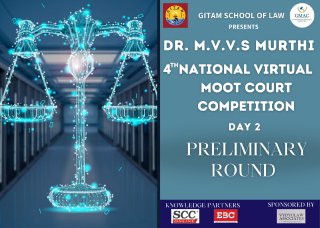
10:00 AM: The curtain rises on the upcoming preliminary rounds, where we will dive deep into the intriguing world of IPR Law!
10:05 AM: All the teams are fully prepared and brimming with enthusiasm as they eagerly await the day’s events to unfold.
10:10 AM: All the Courtrooms are officially in session.
10:07 AM: With unbridled enthusiasm, the court proceedings have commenced as scheduled.
10:16 AM: In Court Room 8, the session commenced with the court manager providing instructions, followed by each team specifying their allotted time for arguments.
10:19 AM: In Court Room 4, Team VMC07 began by outlining their allocated time for arguments and proceeded to introduce the case along with its pertinent facts.
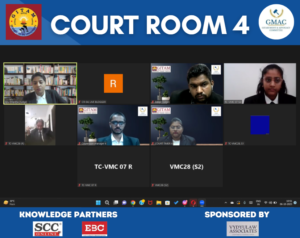
10:21 AM: In Court Room 6, the Hon’ble judge directed the petitioners to commence their arguments and inquired about the jurisdiction of the case during the proceedings.
10:22 AM: In Court Room 3, the honorable judge inquired about the court’s jurisdiction and the prayers outlined in the petition, addressing Team VMC05.
10:24 AM: In Courtroom 2, the petitioner, representing Team VMC 03, argued that there had been a violation of the petitioner’s rights under Article 21 of the Constitution.
10:25 AM: In Court Room 5, Team VMC09, representing the petitioners, initiated discussions on the case’s key issues concerning modern technology and the internet. They specifically addressed concerns related to copyright and infringement of patent rights, indicating that they were seeking legal remedies for these matters.
10:26 AM: In Court Room 12, VMC 23 succinctly introduced the case involving the infringement of sapon technology. They proceeded to present their arguments against the respondent, citing Section 5(2) and Article 21 regarding the right to privacy.
10:27 AM: In Court Room 6, the Hon’ble judge directed a question to VMC 11, inquiring about the significance of consent and intention in cases of copyright infringement.
10:28 AM: In Court Room 3, the judge posed a question to the speakers, asking whether the Writ petition or the Suit takes precedence as the primary consideration. The second speaker from Team VMC05 asserted that the suit would be the primary focus.
10:29 AM: In Court Room 4, Team VMC 07 indicated their intention to address two issues after introducing the first one. However, the honorable judge, Anu Sharma, requested a brief description of the second issue.
10:30 AM: In Courtroom 2, representing the petitioner, Team VMC 03 made a reference to the case of Chintaman Rao v. the State of MP.
10:31 AM: In Court Room 8, the Hon’ble Judge posed a question to the first speaker of petitioner VMC 15, asking under which ministry IPR (Intellectual Property Rights) falls. In Court Room 16, VMC 31, representing the petitioners, outlined the issues they would address and provided an overview of the case’s facts.
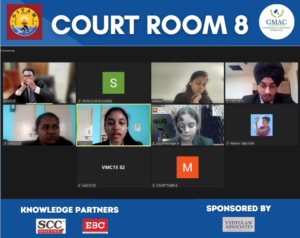
10: 33 AM: In Courtroom 6, the petitioner, Team VMC 11, referred to the case Microsoft Co. vs. MSK Alluri & Ors. Meanwhile, in Courtroom 13, the Hon’ble judge directed a question to the petitioners regarding the jurisdiction of the case concerning the company’s patent and copyright matters.
10: 35 AM: In Court Room 4, following the introductions, the Honorable Judge posed three questions to Team VMC 07: (i) When did the plaintiff allege that the copyright was violated in relation to the product’s functionality?
(ii) What is the plaintiff’s stance on Section 3 of the Patent Act 1970? (iii) What are the grounds for processing personal data in this case?
10: 37 AM: In Court Room 5, Team VMC09, representing the petitioners, summarized the issues related to the violation of Article 21, which pertains to the Right to Privacy. They emphasized that data should not be disclosed to anyone without the individual’s consent, and individuals should not be compelled to provide information.
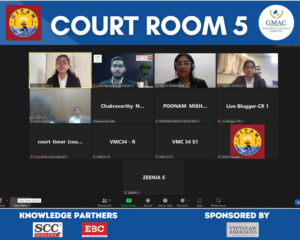
10: 39 AM: In Courtroom 13, the first speaker from Team VMC 10, representing the respondent, argued that the suit is maintainable under the jurisdiction of the High Court and falls within the powers conferred by Article 226 of the Constitution. They contended that the case does not constitute a violation of the right to privacy. They further defended their position by highlighting the advantages of the refrigerator’s advanced technology and asserted that it does not violate the Copyright Act of 1957.
10: 40 AM: In Court Room 12, the petitioner referred to the relevant case of Nirmala Devi vs. Arun Kumar Gupta, which shares similarities with their arguments. They argued that these cases are interconnected and that consolidating them would enhance judicial efficiency. The petitioner concluded their argument, and the next speaker from the petitioner’s side began presenting their arguments. In Court Room 15, VCM29 continued to address the case’s issues, and the judge inquired about the doctrine of fair use during the proceedings.
10: 41 AM: In Court Room 4, Team VMC07 faced numerous questions from the honorable judges regarding Section 51(1) of the Copyright Act 1957. After listening to all the arguments, the judge advised the petitioner to carefully examine Section 14 and Section 15 of the Copyright Act together to determine whether the defendant has the right to violate the copyright or not.
10:43 AM: In Court Room 8, the Hon’ble Judge directed questions to the second speaker of Team VMC 15. The judge asked whether the speaker was familiar with the term GDPR (General Data Protection Regulation) and if so, from which country it was borrowed. Additionally, the judge inquired about the speaker’s knowledge of the DPDP (Data Protection and Privacy) Act, which was passed by the parliament in the month of August.
10:45 AM: In Court Room 1, Team VMC 09, representing the petitioner, referred to the case of Rajagopal vs. State of Tamil Nadu, which is related to the right to privacy. In Courtroom 2, Team VMC 32, representing the respondent, addressed the issues before the Hon’ble Judge. The counsel for the respondent argued on the maintainability of quo warranto.
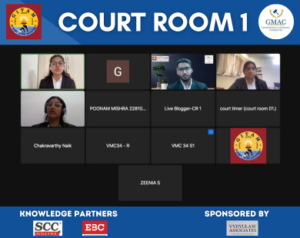
10:46 AM: In Court Room 11, VMC21 Speaker 1 began by presenting the facts of the case, explaining that the petitioner filed the case due to the infringement of copyright and patent rights. They provided a brief overview of the case’s facts and highlighted the issues, including an offense related to cybercrime. In Court Room 10, VMC 19 mentioned the case of MRS R vs. Hamson during their proceedings.
10:48 AM: In Courtroom 2, the Hon’ble Judge directed a question to the respondents, inquiring about the difference between Article 32 and Article 226 of the Constitution of India. In Court Room 10, VMC 19 discussed the potential misuse of personal data and patents, raising the question of whether or not they have been violated.
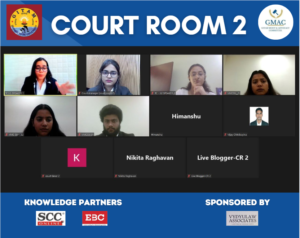
10:50 AM: In Court Room 3, the first speaker from Team VMC05 initiated the arguments regarding the issues at hand. During the presentation, the speaker referred to a landmark judgment relevant to their case. The argument was concluded with the assertion that the Writ petition is not maintainable and cannot be issued against the state. In Court Room 14, Team VMC 27 indicated the division of time for their upcoming arguments.
10:52 AM: In Court Room 6, VMC 11 stated that their contention revolves around the common law right to privacy and referred to the case of K.S. Puttaswamy vs. Union of India. In Court Room 16, Team VMC31 (Petitioners) cited the following cases in their arguments: (i) Apple vs. FBI and (ii) K.S. Puttaswamy vs. Union of India.
10:55 AM: In Court Room 12, the first speaker from VMC23 (Speaker 1) discussed the invasion of customers’ personal and private space, asserting that it is in violation of Article 21. They cited the relevant case of Swamy vs. Union of India. The speaker proceeded with their third argument related to Section 66 of the Patents Act 1970 and concluded by stating that it goes against the state’s public policy. In Court Room 8, the second speaker from Team VMC 15 was questioned by the Hon’ble Judge regarding the importance of data protection within the legal framework and inquired about the legislation pertaining to data protection.
10:57 AM: In Court Room 11, VMC21 Speaker 2 presented additional issues, including (i) Whether there is an infringement of the right to privacy or not. (ii) The judge raised a question about the data storage practices of companies and (iii) whether it constitutes an infringement of the right to privacy.
11:00 AM: In Court Room 3, the counsel from Team VMC05 commenced their argument by asserting that there is an infringement of copyright violation. They referenced the case of Mehta vs. Singh. Additionally, they highlighted the relief sought under section 108 of the Patent Act 1970. The counsel presented the following prayers: (i) The issuance of a writ petition cannot be allowed. (ii) A compensation of Rs. 25 crore is sought. (iii) Any other necessary relief can be provided to the petitioner as deemed fit by the honorable court.
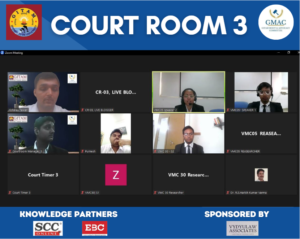
11:03 AM: In Court Room 4, the honorable judge requested the petitioner’s counsel to provide more details about the issue at hand. The petitioner’s counsel elaborated by citing the case of Sashi Bhushan Ray vs. Samantha (Kolkata High Court) as an example. Following this, the honorable judge questioned the counsel about whether they were certain that they had filed the petition in the correct jurisdiction. Based on the counsel’s response, the judge suggested that they investigate the matter to determine the appropriate jurisdiction for the case and then proceed with the claim in that specific jurisdiction. Subsequently, Team VMC07 proceeded with their prayers.
11:07 AM: In Courtroom 2, the Hon’ble Judge posed questions to the respondents, inquiring about whether Fundamental Rights can be waived and seeking an explanation of the difference between Patent and Copyright.
11:10 AM: In Court Room 11, the petitioner’s contentions were concluded, and prayers were presented by petitioner VMC 21, Speaker 2, to the honorable court. The judge asked a question about seeking redressal for copyright infringement and inquired about the relevance of cybercrime in the specific case.
11: 11 AM: In Court Room 6, VMC 24 filed a writ of quo warranto, asserting that it is maintainable under this writ. The Hon’ble judges questioned VMC-24 about the difference between Article 226 and Article 32 of the Indian Constitution and whether the filing procedure was the same in the High Court and Supreme Court. In response, the Respondents (VMC -24) stated that the writ of Article 226 is broader in scope than Article 32 of the Constitution.
11: 13 AM: In Court Room 4, Team VMC28 continued with another issue related to the writ petition and data protection, which was going to be addressed by two of their counsels. The honorable judges requested that they provide a brief description of their issues and the facts of the case.
11:15 AM: In Courtroom 2, Team VMC 32, representing the respondent, prayed to the Hon’ble Court to dismiss the writ petition and further requested the Court to hold the petitioner liable for violating both Patent law and Copyright law.
11:18 AM: In Court Room 9, the honorable judges questioned Team VMC 18 about whether they explicitly mentioned the collection of customer data in their arguments. They also inquired whether simply signing into the privacy policies or agreements of a company would be considered consent given by a customer.
11:20 AM: In Court Room 6, VMC 24 filed for a writ of quo warranto and argued that it is maintainable under this writ. The Hon’ble judges inquired about the difference between Article 226 and Article 32 of the Indian Constitution and whether the filing procedure was the same in the High Court and Supreme Court. The Respondents (VMC -24) replied that the writ of Article 226 is broader in scope than Article 32 of the Constitution.
11:21 AM: In Court Room 4, Team VMC28 proceeded with another issue related to a writ petition and data protection, which was to be addressed by two of their counsel. The honorable judges asked them to provide a brief description of their issues and the facts of the case.
11:22 AM: In Courtroom 2, Team VMC 32, representing the respondent, prayed to the Hon’ble Court to dismiss the writ petition and also requested that the petitioner be held liable for violating Patent and Copyright.
11: 24 AM: In Court Room 4, the respondent introduced their first issue, and the honorable judge inquired from the respondent whether the writ petition should be maintained or not. Following the respondent’s response and further discussion of the issue’s facts, the honorable judge asked about the respondent’s standpoint and whether they genuinely agreed with it, thus concluding the discussion of the first issue.
11:25 AM: In Court Room 16, the honorable judge posed several questions to the petitioner counsel, VMC31: (i) Whether the Right to the profession has been infringed or not. (ii) Whether the IPR rules are unconstitutional in this case? (iii) How many judges were on the bench in the case of K.S. Puttaswamy vs. Union of India? (iv) In which year was the case K.S. Puttaswamy vs. Union of India decided?
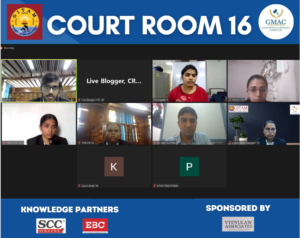
11:30 AM: In Court Room 8, the Hon’ble judge questioned the respondent about the period of protection for copyright, to which the speaker provided a response. Speaker 2 continued the proceedings and cited the case of Eastern Book Company vs. D.B. Modak, stating that the legal principle laid down in the above case is that derivative work can claim protection under the Copyrights Act as it involves skill and work.
11: 31 AM: In Court Room 11, VMC14 Speaker 1 began the contention by briefing the facts, and the Honorable Judge questioned the jurisdiction of the case. In Court Room 16, the proceedings concluded successfully.
11: 33 AM: In Court Room 15, the respondent, VMC06, stated that no copyright infringement had occurred. The council rebutted the statement made by the petitioners regarding the binding nature of the agreement, and the respondent challenged the writ of quo warranto filed by the petitioner. The Hon’ble judge asked the respondent if a quo warranto can be filed by a person who has no locus standi.
11: 35 AM: In Court Room 12, VMC12S2, the respondent, began her arguments regarding modified software and patent material functionality, emphasizing that the functions of both products are different. They mentioned the case Nazomi vs. Nokia. The Hon’ble judge questioned the functionality of both products’ software.
11: 37 AM: In Court Room 8, the Hon’ble Judge questioned Speaker 2 of Team VMC 20 about the importance of consent and the transmission of data without the knowledge of customers by the company. In Court Room 8, the Hon’ble Judge questioned Speaker 2 of Team VMC 20 about the importance of consent and the transmission of data without the knowledge of customers of the company.
11:38 AM: In Court Room 3, Team VMC30’s co-counsel concluded their arguments, focusing on Section 14A of the Copyright Act and Section 108 of the Copyright Act. As they approached the end of their allotted time, extra time was granted to the co-counsel to conclude the arguments and the session with their prayer for the reliefs sought.
11:40 AM: In Court Room 4, the honorable judge posed questions to the respondent, inquiring about which law would be applicable whether granting patent rights and copyright is considered a public right or not, and whether it violates the right to privacy. The respondent provided an answer with the example of Sahani Puni vs. the Union of India. They also explained the technological advancement and the legitimate aim that technology is trying to achieve. Following this, the honorable judge asked whether the petitioner had saved the customers’ call records and audio or not, as the respondent accepted their assertion. This concluded the discussion on the two issues.
11: 42 AM: In Court Room 12, the Honorable Judge questioned the installation of the product’s software, and VMC12S2 responded by referring to Section 107 of the Patent Act 1970 as grounds for defense. They also mentioned the lack of novelty in Section 66 and referred to Bingo Infrastructures.
11:43 AM: In Court Room 14, the Honorable Judge expressed dissatisfaction with the justification provided by VMC 08 (Speaker). In Court Room 7, the proceedings were successfully completed.
11:50 AM: In Court Room 4, the Respondent proceeded with their issues, asserting that the present petition’s maintainability is in question. They argued that the petitioner did not follow the proper procedure for filing a writ petition and instead filed it directly in the high court. Additionally, they mentioned the Doctrine of Pith and Marrow and contended that their intention is valid as per Section 111 of the Copyright Act 1957.
11: 52 AM: In Court Room 11, VMC14 Speaker 2 sought permission from the Honorable Judge to present their prayers. They requested the court to remove the replicated version from the online forum and sought compensation of 25 crore. Additionally, they stated their request to dismiss the writ of quo warranto.
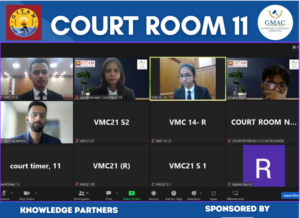
11:53 AM: In Court Room 3, the the team VMC30, the co-counsel has concluded their prayer stating that the Rupees 25 crores has to be given to them and the petition will not recognized by the court and any reliefs which can be granted by the court to the council. Both teams have summed up their arguments and the session has been ended by the Honourable Judges.
11:54 AM: In Court Room 8, both teams are done with their rebuttals and proceedings have been successfully concluded.
11:56 AM: In Court Room 15, the judge asked whether hacking is allowed for a good cause. The respondent responded by stating that the privacy policy of the state is sufficient and concluded with prayers.
11:57 AM: In Court Room 11, after the arguments were concluded, the petitioner asked a question to the respondents, inquiring how quo warranto can be filed against a company and whether a company can be considered a state. VMC14 Speaker 1, representing the respondent, contended that it is the duty of the state to ensure that the patent rights are protected and enforced. Following this, rebuttals were made, and the proceedings ended.
12:00 PM: In Court Room 14, the Hon’ble Judge asked VMC 08 Counsel to provide an explanation of the term “originality.” Additionally, the Hon’ble Judge questioned whether the modification made was for the benefit of the public but not for commercial use. Team VMC 27 requested counsel for rebuttal time, which was granted, and they concluded their submission for rebuttal.
We have arrived at the end of the first session of the preliminary rounds!
Preliminary Rounds Session 2
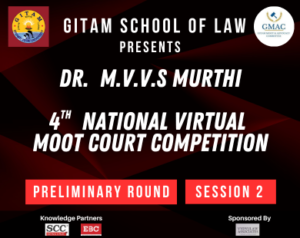
2:00 PM: All participants are now prepared to compete against one another in the second session of the preliminary rounds.
2:04 PM: The formal proceedings in all the courtrooms have now commenced.
2:07 PM: In Courtroom 14, Team VMC 28 has provided their respective time allocation for presenting their argument.
2:08 PM: In Courtroom 13, the speakers from VMC26 began by outlining the facts and issues of the case. Meanwhile, in Courtroom 2, the counsel representing Team VMC 04 as the petitioner informed the court that they had three issues to present before the court and requested permission to proceed with their pleadings.
2:10 PM: In Courtroom 8, the petitioners from Team VMC 16 commenced their arguments by invoking the writ of quo warranto as outlined in Article 226 of the Indian Constitution. They also referenced the case of Pawan Kumar vs. the State of Haryana as part of their presentation.
2:12 PM: In Courtroom 16, the session was initiated by the court manager, who provided instructions to both parties and outlined the time allocation for their arguments.
2:14 PM: In Courtroom 14, VMC 28’s first speaker began by presenting the issues of the case. Additionally, they mentioned that Article 226(1) of the Indian Constitution grants every High Court the authority to issue orders or writs.
2:15 PM: In Court Room 5, Team VMC10 initiated their presentation by addressing the issues of the case. Meanwhile, in Courtroom 10, Team VMC20 is discussing the establishment of copyrights and instances of infringement.
2:17 PM: In Court Room 09, The court manager has initiated the session by acknowledging the division of time. In Court Room 03, Team VMC06’s speaker 1 has commenced with their pleadings.
2:18 PM: In Court Room 15, the petitioner (VMC24), speaker 1, initiated their argument by discussing the suit of infringement related to Section 2(1)(c) of unregistered patent rights. Furthermore, the speaker addressed the 7th issue from the memorandum on page 20, which argues that the writ petition is not maintainable, and also cited the case of Mahesh Chandra Gupta vs. AK Mishra in support of their argument.
2:20 PM: In Court Room 6, VMC 12 began by presenting the facts and issues of the case. In Court Room 16, VMC 32, speaker 1, initiated the arguments by discussing the facts and issues of the case.
2:23 PM: In Court Room 3, the first speaker from Team VMC06 began their argument by addressing the issues raised in the facts: (i) The speaker initiated their argument by discussing Section 51 of the Copyright Act 1957, which pertains to the infringement of Copyright. (ii) They pointed out that Copyright is protected under the Copyright Act 1957.
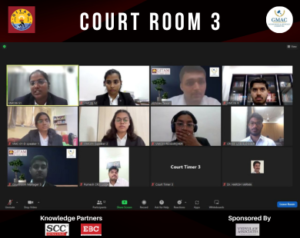
2:25 PM: In Court Room 14, the Hon’ble Judge raised a question to VMC 28 (Speaker 1) regarding the clarity of his argument, expressing that it was not as clear as the memorial.
2:28 PM: In Court Room 11, before commencing the proceedings, there is an issue concerning the submission of the memorial, and the court manager is currently addressing and resolving the matter.
2:30 PM: In Court Room 12, VMC24, petitioner’s speaker 1, concluded his argument by referencing the Whirlpool case, which was not directly related to the violation of public policy. The Honorable Judge raised a question regarding the relevance of the case, pointing out that it did not seem to pertain to a commercial case. Subsequently, VMC24 (Speaker 2) began her argument as the time allotted for the 1st speaker had expired.
2:31 PM: In Court Room 5, VMC10 Speaker 2 referenced the cases Pawan Kumar Vs. State of Haryana and Chunni Lal Mehta during their argument. In Court Room 4, the court manager initiated the session by providing instructions and directions for time management to both participating teams.
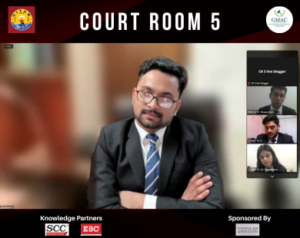
2:32 PM: In Court Room 16, speaker 1 of the team VMC32, cited the following cases in relation to issue 1: (i) Dulabhai v. State of Madhya Pradesh (ii) R. Rajagopal v. State of Tamil Nadu (iii) K.S. Puttaswamy v. Union of India
2:33 PM: In Courtroom 2, the Hon’ble Judge directed a question to the counsel representing Team VMC 04 (petitioner). The question pertained to whether their client had thoroughly read and understood all the conditions specified in the agreement. Furthermore, the Hon’ble Judge wanted clarity on how there could be a violation of the Right to Privacy when there is consent provided by the petitioner through their agreement to the mentioned conditions.
2: 35 PM: In Court Room 16, VMC32 Speaker 1 referenced the following legal provisions: (i) Section 3 of the Patent Act 1970 (ii) Section 64 of the Patent Act 1970 (iii) Section 83 of the Patent Act 1970 Additionally, they cited the following cases: (i) Rupa Sharma v. State of U.P. (ii) State of Maharashtra v. Indian Hotel and Restaurant Association
2:37 PM: In Court Room 15, the proceedings began with VMC30, who presented the issues of the case. Speaker 1 asserted that there is a violation of fundamental rights and argued that the writ petition under Article 226 of the Constitution is valid. In Court Room 14, VMC 28 (Speaker 2) cited the case of Hindustan Lever Ltd. vs. Godrej Soap Ltd. in relation to issue 2.
2:38 PM: In Court Room 6, the Hon’ble Judge inquired about the statement of jurisdiction. The petitioners, VMC-12, responded by explaining that they initially filed for a Writ of Mandamus but now intended to file under Article 226 of the Constitution, citing a violation of a legal right. They also mentioned having pecuniary jurisdiction to file the case in the High Court. The Hon’ble Judge then responded by referring to Section 5 of the Delhi High Court and Commercial Court Act, indicating that the chosen forum might not be appropriate for their case.
2:39 PM: In Court Room 3, both speakers from Team VMC06 approached the case from different perspectives, considering it as both a civil suit and a petition. However, the High Court expressed the intention to consolidate or combine the issues that were presented in the case’s facts as the arguments progressed.
2:40 PM: In the courtroom, VMC20 (Speaker 2) was asked by the honorable judges to provide a case to support the argument of patent infringement and explain it in detail. The petitioner (Speaker 2) referred to the case of Bajaj Auto Ltd. v. T Author Company to support their argument.
2:42 PM: In Court Room 15, the Hon’ble judge asked Speaker 1 what is the reason for filing the writ of quo warranto. In Court Room 5, Speaker 2 of VMC10 requested a 2-minute extension to conclude their submission. The Judge duly agreed to their request and granted an extension.
2:44 PM: In Court Room 8, speaker 2 of team VMC 16 was asked by the Hon’ble judge to acknowledge the restrictions available under the right to privacy under Article 21 of the Indian constitution, and as well as the Hon’ble judges also asked them to cite the relevant precedents for their response to the previous question.
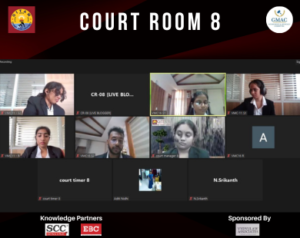
2:45 PM: In Court Room 09, Speaker 1 of VMC18, states several sections such as 107,65,52,52, 48 of the Patent Rights Act 1970 and asks for the revoke of the patent. Speaker 2 states whether the copyrights of software lead to infringement or breach of the right to privacy. The team Submitted the prayers before the honorable Judge.
2:47 PM: In Court Room 14, VMC 28 presented their arguments and asked for permission for prayer which was granted, and concluded the issues. In Court Room 6, The Hon’ble Judge while referring to the Data Privacy Act 2023 passed in 2023 stated that notice has to be provided and so the petitioners VMC12 has to submit notice as well.
2:50 PM: In Court Room 12, the Honorable Judge raised questions about software, code, and their distinctions. Following this, the respondent, VMC19 (Speaker 1), began presenting their argument, focusing on patent issues and property disputes under Article 56(a) of the Indian Constitution. However, the Judge questioned the maintainability of other remedies. VMC19 (Speaker 1) mentioned civil remedies related to account profits, prompting the Judge to inquire why a mason would file a suit against such remedies.
2:53 PM: In Court Room 14, the Hon’ble Judge asked the counsel whether a patent should be granted based on criteria such as Novelty. They also mentioned that when discussing a product, one should consider it from a commercial perspective. After these points, the Hon’ble Judge questioned whether infringement had occurred or not.
2:55 PM: In Court Room 15, the Hon’ble Judge asked Speaker 2 how they have justified the consent provided by users in the privacy policy. Additionally, the Judge inquired whether the users were aware of the recording of their information.
2:57 PM: In Court Room 5, the Hon’ble Judge advised Team VMC13 that it is essential to inform clients before obtaining their data, and the team had not mentioned this point. The Judge recommended reading the Information Technology Act 2000 for further clarification on this matter.
2:58 PM: In Court Room 09, the respondent VMC21 (Speaker 1) presented the issues before the Honorable Judge and mentioned Section 15 of the Indian Contract Act 1872, emphasizing the importance of free consent from customers or subscribers. The Judge then raised a question, inquiring whether it was disclosed in the agreement that the audio logs of customers would be recorded. The Judge also asked whether this lack of disclosure could potentially lead to misrepresentation.
2: 59 PM: In Court Room 7, VMC 09 referenced Article 226 and Section 104 of the Patent Act 1970 in their argument. The Honorable Judge then questioned the respondent, asking if the facts they mentioned were concurrent. Additionally, the Judge asked why there was a need for voice command functionality in a refrigerator and requested an explanation of the primary function of a fridge.
3:00 PM: In Court Room 4, the Hon’ble Judge asked Team VMC08 about the process of seeking a remedy through a writ petition and inquired about how statutory provisions ensure this limitation. Following this, the Judge asked whether the state violated public property by granting copyright and patents to the kind of product that Sephon Company was providing. Team VMC08 responded by providing an example from a case law, which pertains to personal privacy. This concluded the argument for the first issue presented by the petitioner.
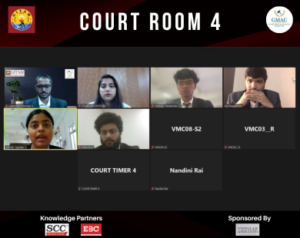
3:03 PM: In Court Room 3, Speaker 2 argued that there is a violation of Article 21, and public interest is also being violated. The Judge raised questions regarding jurisdiction, and Speaker 2 provided explanations regarding the hierarchy of the courts under the Constitution of India. After addressing the questions, Speaker 2 concluded their arguments and prayed to the Honorable Court, requesting that: The Writ Petition be deemed maintainable, and compensation of Rs. 25 crore be awarded for the infringement of Copyright. Following this, Team VMC01 began their pleading.
3: 05 PM: In Court Room 14, Team VMC 31 submitted their prayer for reliefs sought and memorial before the Hon’ble Judges.
3: 07 PM: In Court Room 5, VMC13 referred to Section 57(1)(b) of the Copyright Act 1957, which allows the copyright holder to restrain or claim damages for any distortion, mutilation, modification, or other act related to the work that could harm their honor or reputation. They argued that they are entitled to compensation under this provision.
3:08 PM: In Court Room 16, VMC 27 (Speaker 2), with the permission of the Honorable Judge, began presenting their arguments. In courtroom 10, VMC23 (Speaker 1) mentioned the case of Raja Sara Ramji Bai vs. Rana Mohabbat Singh. In response, the Judge asked VMC23 (Speaker 1) to state the facts of the case and provide evidence demonstrating the validity of the contract between the parties involved.
3:10 PM: In Court Room 16, VMC 27 (Speaker 2), with the permission of the Honorable Judge, began presenting their arguments.
3:12 PM: In Court Room 4, Team VMC08 provided an explanation regarding the interpretation of the privacy policy in data protection and discussed the discovery of a breach. They also elaborated on the content of Article 21 of the Indian Constitution. Subsequently, they proceeded with their prayer and concluded their arguments.
3:15 PM: In Court Room 10, the petitioners, represented by VMC20 (Speaker 1), began their presentation by addressing the rebuttals related to the argument that the writ of quo warranto is not maintainable. In Court Room 11, the Honorable Judge posed a question, asking the speaker to mention cases related to public policy during the proceedings.
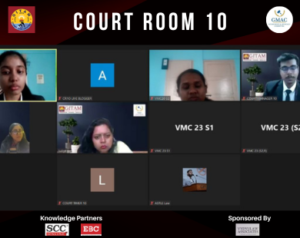
3:16 PM: In Court Room 14, Team VMC 28 initiated their rebuttal and questioned VMC 31 (Respondent) regarding their argument that “Right to Privacy” is not a part of the constitution. They asked the Respondent to justify their stance in light of the case “K.S. Puttaswamy vs. UOI,” which is known for its significance in establishing the right to privacy in the Indian Constitution.
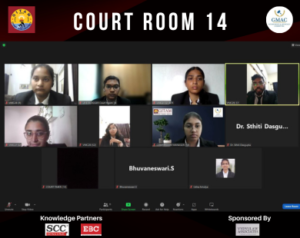
3:18 PM: In Court Room 3, Team VMC01 (Speaker 1), completed presenting the facts and then began arguing that there was a violation of copyright. They invoked the Doctrine of Equivalence, specifically referring to sections 104 to 111 of the Copyright Act of 1957, as well as the Doctrine of Fair Dealing, citing section 52 of the Copyright Act 1957.
Following this, the Judge posed a question about the role of intention in civil cases and asked whether “mens rea” is a legal term applicable to civil or criminal cases. Speaker 1 then proceeded to justify the actions in question by arguing that they were justified under the doctrines mentioned earlier. Subsequently, Speaker 2 began presenting their arguments related to the issues at hand.
3:20 PM: In Court Room 6, the Hon’ble Judge asked the respondents to specify the statutory provisions that make Mason’s act of making modifications fair. Additionally, the Judge inquired why Mason had not approached the right forum for their case.
3:23 PM: In Court Room 17, the Hon’ble Judge advised participants to stay aware of the memorials, refer to relevant case laws, and familiarize themselves with the facts of the jurisdiction. Following this advice, the proceedings in the courtroom concluded.
3:25 PM: In Court Room 7, the Honourable Judge asked VMC 09 (respondent) about the decision in the Tolly Bag landmark case. Once the respondent provided their answer, they proceeded with their rebuttal arguments.
3:28 PM: In Court Room 4, the respondent explained the four stages of a legitimate aim and the necessity stage for their case. In response, the Hon’ble Judge asked about the duty of AI and also inquired about the significance of Section 64 and Section 66 of the Patent Act 1970. The respondent then provided explanations, citing case laws including Biswanath Prasad Radhey Shyam vs. HM Industries and Bajaj Auto Ltd vs. TVS Motor Ltd.
3:30 PM: In courtroom 16, the proceedings had been ended successfully.
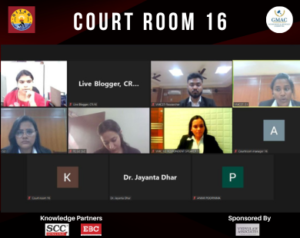
3:33 PM: In Court Room 8, Speaker 2 of Team VMC 11 was questioned about whether fundamental rights include considerations of public interest.
3:35 PM: In Court Room 3, Speaker 2 stated that there is a violation of Article 21 of the Constitution of India, which relates to the right to privacy. They cited two case laws: (i) People Union Association vs Union of India and (ii) K.S. Puttaswamy vs Union of India. Additionally, Speaker 2 mentioned Section 11 of the Digital Data Protection Act 2023 in connection with the case of K.S. Puttaswamy vs Union of India.
3:38 PM: In Court Room 4, Team VMC03 explained the concept of quo warranto and argued that the Copyright and Patent Acts were not in violation of quo warranto. The Hon’ble Judge then posed questions to VMC03, asking them to explain: (i) What constitutes a breach of the agreement? (ii) The concept of the Right to Reputation.
(iii) The significance of Section 4(1) of the Sales of Goods Act 1930. These questions sought clarification and further elaboration on the relevant legal concepts and provisions.
3:40 PM: In Court Room 8, both teams have completed their rebuttals, and the session has concluded successfully.
3:42 PM: In Court Room 4, Team VMC03 conveyed to the Hon’ble Judge that their client had not attempted any infringement or violation of copyright or patent. As a result, the respondent concluded their arguments.
3:45 PM: In Court Room 11, Team VMC17 (Speaker 1), initiated the proceeding by addressing the issue of whether the High Court has jurisdiction over the matter. They argued that there is an infringement of copyright, as the defendant had modified and published online without the company’s consent. Speaker 1 contended that the defendant should be held liable for hacking, modifying, and publishing online, which is violative of certain penal provisions.
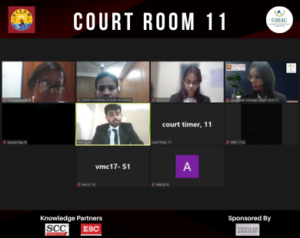
3:48 PM: In Court Room 4, both teams completed their rebuttals, and the session successfully concluded and ended.
3:50 PM: In Court Room 7, Team VMC 09, in response to a question posed by the Honorable Judge, mentioned Section 47 of the Patent Act and Section 52AC of the Copyright Act 1957.
3:52 PM: In Court Room 15, the Honorable Judge asked whether the judgment of the High Court is binding on this court, and this query was followed by the prayers of the respondent, VMC 33.
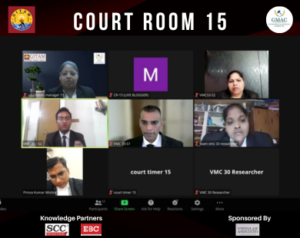
3:55 PM: In Court Room 6, both teams completed their rebuttals, and the session successfully concluded and ended.
4:00 PM: In Court Room 11, the respondent (VMC 17) Speaker 2 contended that the defendant’s actions constituted a violation under the Information Technology Act, 2000. They specifically mentioned Section 43 of the IT Act, 2000, and argued that the use of a computer without the owner’s permission was liable for the violation of fundamental rights.
We now arrive at the end of session 2 of the preliminary rounds!
After a challenging day of the preliminary rounds, we are thrilled to announce the teams that have secured a spot in the Quarter-Finals:
CONGRATULATIONS TO THE TEAMS!!!
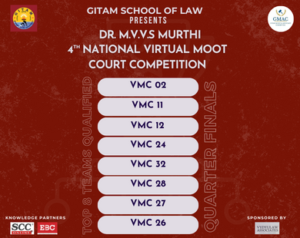
With DAY 2 behind us, we’re eager to dive into DAY 3!
DAY 3
07th OCTOBER, 2023
Quarter-Finals
Quarter-finals are here! Get ready for some thrilling legal battles in this prestigious competition…
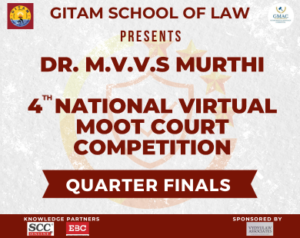
10:00 AM: The Courtrooms are all set for the commencement of the Moot Court Quarter-Finals in the morning session. All the best to the Qualifying teams!
10:01 AM: All the four courtrooms are officially in session.
10:02 AM: In Court Room 2, the proceedings have commenced, and the VMC 11, Speaker 1 (petitioner) has been tasked by the Honourable Judges to present a concise summary of the key facts of the case.
10:03 AM: In Court Room 1, The petitioner (VMC 02) has pleaded the Right to Privacy enshrined under Article 21 of the Constitution, and has started presenting the issues, the judges have raised a query to the petitioner to clarify the issues being presented and argued upon.
10:04 AM: In Court Room 3, Speaker 1 of VMC 12 inquired with the judges about their satisfaction with the presented facts before proceeding to discuss the issues. The judges requested a concise presentation of the case’s background and facts.
10:05 AM: In Court Room 4, Team VMC 24 has been presenting its arguments, and the Honorable Judge is seeking clarification about the facts and the background of the case. They have also asked about the seizure notice and questioned why the Honorable High Court was approached for this matter.
10:07 AM: In Court Room 1, the petitioner VMC 02 referred to the case of Manohar Lal Sharma vs. Union of India and claimed a violation of the Declaration of Human Rights and ICC. They also cited Justice K.S. Puttaswamy (Retd) vs. Union of India in their arguments.
10:10 AM: In Court Room 2, the Honorable Judges asked the petitioner VMC 11, Speaker 1 to provide insights into how the issue of privacy concern came to light, specifically mentioning Henry’s involvement.
10: 12 AM: In Court Room 3, VMC 12 – Speaker 1 was asked by the Judge to explain to the bench the jurisdiction under which they have filed the case. The speaker clarified that they had approached the High Court under Article 226.
10:15 AM: In Court Room 4, the Judge requested Team VMC 24 to share their screen to show highlighted facts related to creating a modified software and uploading it to the forum as discussed in their argument.
10:17 AM: In Court Room 1, the discussions revolved around the Universal Declaration of Human Rights and the European Convention for Human Rights. The Honorable judges questioned the difference between the storage and collection of data and also inquired about why the petition was not maintainable in the Honorable High Court.
10:20 AM: In Court Room 4, VMC 24 discussed legal precedents such as the Puttaswamy case, which established privacy as a fundamental right. The judge questioned if they had considered alternative remedies, to which Team VMC 24 responded that they were not approaching under Article 226. They justified that their suit was maintainable under the Commercial Courts Act, as the present case was a commercial dispute under the act, and they also cited Section 104 of the Patents Act 1970.
10:23 AM: In Court Room 1, speaker 2 of VMC 02, took up the Third Issue, challenging the original patent granted to the defendants.
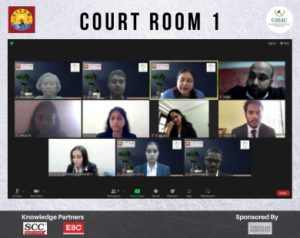
10:25 AM: In Court Room 4, VMC24 provided reasoning for not approaching the district court, but the honorable judge pointed out that they might have misinterpreted the law regarding the district court’s jurisdiction in this matter.
10: 28 AM: In Court Room 2, Speaker 2 of VMC11, emphasized the importance of Rule 4 of the Information Technology (Reasonable Security Practices And Procedures And Sensitive Personal Data Or Information) Rules 2011.
10:30 AM: In Court Room 2, speaker 2 of VMC 11, quoted the case of K.S. Puttaswamy vs. Union of India to support and strengthen their argument.
10:32 AM: In Court Room 2, VMC 2 has shifted its focus to the issue of feasibility of copyrights and patents vis-a-vis public policy.
10:35 AM: In Court Room 1, Speaker 2 of, VMC02, cited several cases, including Dr. Jagjit Singh vs. Giani Kartar Singh, Campbell v. MGN Ltd, University of Oxford v. Rameshwari Photocopy Service, and Harper & Row v. Nation Enterprises, to explain that Mr. Maison had no intention to harm the company but was merely invoking the fair use doctrine.
10:37 AM: In Court Room 3, Speaker 2 of VMC12, addressed the issue of whether the right to privacy can be breached by a contractual term. The Judge inquired under which act the case is maintainable, whether it falls under the Patent Act or the Copyright Act. The Speaker for VMC02 claimed exceptions under Section 52A & B and Section 2(o) of the Copyright Act 1957.
10:38 AM: In Court Room 2, Speaker 2 of VMC11, concluded their argument by quoting the case of Novartis vs. Cipla on Onbrez. The counsel then moved on to present their prayer.
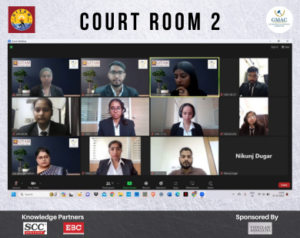
10:40 AM: In Court Room 4, VMC 24 discussed the issue that software is available for open use. They explained that they initially obtained a copyright for it and then developed another element for its functioning, for which they obtained a patent.
10:41 AM: In Court Room 4, the judge questioned the team VMC24, about the specific part they were copyrighted in the software, particularly focusing on the modifications they made instead of the software that is freely available. They also asked about the applicability of a principle they had used. VMC24 answered that it is still applicable to a part of the software, citing the case of Ethen Book Company vs. Modak. They argued further, establishing the concept of a minimum level of creativity required for copyright, and supported their statement.
10: 42 AM: In Court Room 1, the Judge questioned the speaker of VMC02, about whether the judgment of the Supreme Court in a case with highly peculiar facts always overrides provisions of an act of parliament. The speaker concluded with the relevant case law and then proceeded to present the prayers as requested by the judge.
10: 45 AM: In Court Room 2, Speaker 1 VMC 28, mentioned that the petition of quo warranto filed by the petitioner is maintainable. Judges have asked to clarify which party the defendants are representing.
10: 48 AM: In Court Room 3, Speaker 2 of VMC 12, requested an injunction in their prayer. The judge inquired about the pillars on which the injunction order should be based and what would satisfy the court for granting the injunction. Additionally, the judge asked for a separate application for the injunction.
10: 50 AM: In Court Room 4, VMC 24 discussed the issue of whether the defendant violated copyright and patent. They relied on the case of Blackwood and Sons vs. Parasuraman and talked about the concepts of originality and model. They also discussed the right of integrity and the use of fair use under the Copyright Act 1957.
10:52 AM: In Court Room 2, the judge mentioned that the memorial presented by the respondent was considered wrong by the judges. They noted that the respondents had presented more or less the same contentions as the petitioner, indicating a similarity in their arguments.
10:55 AM: In Court Room 2, Speaker 2 of VMC 28, has started with the further contentions of the respondents.
10:57 AM: In Court Room 3, Speaker 1 of VMC 27, stated that they have clubbed their writ and suit, suggesting that they have combined these elements in their legal strategy.
10:58 AM: In Court Room 4, the honorable judge asked the team VMC 24’s, about the sections of the doctrine of fair use and how their infringement falls under the right to fair use. The speaker then submitted that the defendants had infringed by modifying the software, which harmed its integrity and reputation. Regarding the issue of patent rights infringement, the judge inquired if there was any commercial gain after the modification, which is an important consideration for the grant of a patent. They also questioned whether it was against public policy.
11:00 AM: In Court Room 3, Speaker 1 of VMC 37, proceeded with issues 1 and issue 2.
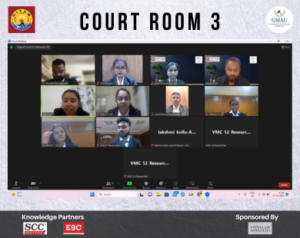
11:02 AM: In Court Room 3, speaker 1 of VMC 27, was asked whether the rule of Alternate efficacy relief is mentioned in the constitution.
11:04 AM: In Court Room 4, VMC24 answered that the modifications were made not for commercial gain but for the convenience of users. However, the judge continued to question the point that they hadn’t informed the users that they were taking their data without consent and were now stating it was for their convenience.
11:08 AM: In Court Room 2, the judges asked about the applicability of The Digital Personal Data Protection (DPDP) Act 2023 in the present case, assuming that the case came to light after the enforcement of the Act.
11:10 AM: In Court Room 1, the honorable judges asked the counsel to provide a judgment where both fundamental rights and the infringement of contractual obligations were addressed. The counsel expressed their inability to find the said judgment.
11:12 AM: In Court Room 3, Speaker 1 of VMC 27, was asked by the judge to provide a judgment where audio logs are separated from the apparatus. The judge also inquired whether the system could function effectively if audio logs were removed.
11:15 AM: In Court Room 1, Speaker 2 of VMC32, began explaining how the patent is unique and novel, and how Mr. Maison had infringed their proprietary rights over the software in question.
11:17 AM: In Court Room 3, Speaker 1 of VMC 27, faced a question from the judge about whether an AI (Artificial Intelligence) system can work without user input and whether it can make suggestions on its own when data is not fed into the system.
11:18 AM: In Court Room 4, VMC 24 mentioned a few cases related to the doctrine of colorable legislation. The judge questioned them about using the software for reverse engineering for research purposes, suggesting it’s not prohibited, so how did it violate? VMC 24 clarified that they had modified the software and not used it for research purposes. They then moved on to their submission regarding the justification for their statements.
11:20 AM: In Court Room 3, to Speaker 1 of VMC 27, the judge asked whether the system could differentiate between sensitive personal data and personal data.
11:21 AM: In Court Room 2, VMC 28 has moved on to the prayer stage, and the rebuttal has begun by VMC 11.
11:23 AM: In Court Room 4, VMC 24 submitted that the modification wouldn’t be considered fair use as they are using a substantial part of it, thus infringing on their rights. They prayed for an injunction order to stop all infringing activities.
11:25 AM: In Court Room 3, Speaker 1 of VMC 27, concluded their arguments, and VMC 27 Speaker 2 started presenting their arguments.
11:30 AM: In Court Room 3, VMC 27, Speaker 2 was asked by the judge to provide an example of a case where the separation of the instrument from the overall device has been mentioned.
11:33 AM: In Court Room 4, VMC 26 mentioned the case “Sanjay Pandey vs. Directorate of Enforcement,” and the judge asked about the specific portions of agreements they were referring to. The speaker referred to the Information Technology Act and brought up the doctrine of fair dealing.
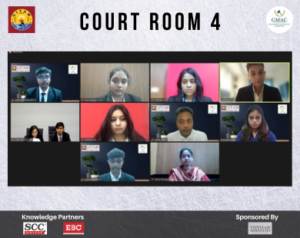
11:35 AM: In Court Room 3, VMC 27, Speaker 2 was directed by the judge to proceed directly to the prayer.
11:40 AM: In Court Room 3, the rebuttal has started by VMC 12.
11:42 AM: In Court Room 3, the proceedings have concluded, and the Honorable judges are providing feedback to the teams.
11:45 AM: In Court Room 4, VMC 26 discussed the right to information and cited the case of State of UP vs. Raj Narain, along with the right to freedom of expression. They argued that copyright is not infringed according to Section 52 of the Copyright Act 1957 when used for research purposes. The judge questioned them about private or personal use when they put it on a public platform and asked about their approach to the Honorable Supreme Court or High Court with a PIL (Public Interest Litigation).
11:49 AM: In Court Room 1, the honorable judges have granted permission for rebuttals in the courtroom.
11:50 AM: In Court Room 4, the judge discussed the concept of “Procedure established by law” and mentioned that reverse engineering doesn’t come under this category. The speaker then provided justification for this question.
12:00 PM: In Court Room 4, the speaker of VMC 26, mentioned the case of Rajgopal vs. the State of Tamil Nadu in the context of the right to speech and expression and the right to information. Speaker 2 then addressed the issue of whether the writ petition is maintainable or not and stated that it is not maintainable due to the absence of valid essentials.
12: 05 PM: In Court Room 4, Speaker 2 of VMC 26, spoke on behalf of Henry Mason, addressing Section 52 of the Copyright Act 1957 and discussing open-source software and its modification. The judge questioned the protection under patent when used under copyright, and Speaker 2 then proceeded to offer prayers before the bench.
12:10 PM: In Court Room 4, the speaker of VMC 24, raised questions regarding Section 43 of the IT Act 2000, pointing out that it applies to wrongful usage in cases of information leaks. The speaker questioned how the software was modified, emphasizing that the right to information is typically available only to the state. Additionally, they referred to the moot proposition’s prohibited activities section, noting that reverse engineering was not explicitly mentioned as one of the prohibited activities.
12:15 AM: In Court Room 4, the speaker of VMC 26, answered the questions posed by VMC 24. They also raised a question about whether market share is more important than the fundamental rights of citizens.
We now arrive at the end of Quarter-Finals!!!
After a highly competitive Quarter-Finals session, here are the teams that have successfully advanced to the Semi-Finals
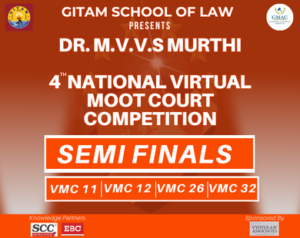
CONGRATULATIONS TO THE TEAMS!!!
As we gear up for the captivating Semi-Finals, teams are poised to face off in an exhilarating showdown. Best of luck to all participants!
TEAMS:
In Court room 1, VMC12 v. VMC 26
In Court room 2, VMC11 v. VMC 32
2:00 PM: Courtrooms 1 and 2 are officially in session!
2:05 PM: In Court Room 2, The session commenced, with VMC 32 starting off by presenting the facts.
2:07 PM: In Court Room 1, the session has started.
2:08 PM: In Court Room 2, the judge raised a question about the ‘civil appeal’ mentioned in their memorial, and VMC 32 clarified that the writ petition is maintainable.
2:12 PM: In Court Room 1, VMC 26 started by presenting the facts, and they questioned whether Seppon Technology could hold a valid copyright.
2:15 PM: In Court Room 2, VMC 32 argued that the cause of action arose in their jurisdiction, justifying the jurisdiction of the high court. They referred to some cases of territorial jurisdiction. The judge asked why a writ petition under Article 226 was evoked, and VMC 32 justified it with cases like Rajendra Singh vs. Anita Singh, which pertained to quo warranto writs. However, the judge raised a question about changes in the line of law after the Rajendra Singh case and why they couldn’t go to other authorities under the appellate board or authorities under patent law.
2:18 PM: In Court Room 2, VMC 32 submits that quo warranto is maintainable. The judge asked for recent cases.
2:20 PM: In Court Room 2, VMC 32 argues that the grant of a patent is inconsistent with patent law and fundamental rights like the right to privacy and the right to choose. They question whether there has been infringement and refer to the Raj Gopal vs. State of Tamil Nadu case, as well as the Puttaswamy judgment. They put forward some of the honorable Supreme Court’s emphasis in this regard.
2:25 PM: In Court Room 1, VMC 26 states Section 43 of the Information Act and claims that the work of Mr. Mason harmed the reputation of the company.
2:30 PM: In Court Room 1, The judge asked the team VMC 26, for a precedent that is linked to Section 3 of the Patents Act.
2:35 PM: In Court Room 1, The judge questions VMC 26, about whether the patent authority is considered a judicial body.
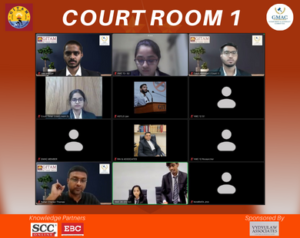
2:38 PM: In Court Room 2, Speaker 1 of the team VMC 32, discusses the grant of patents and violations related to ethics and morality.
2:40 PM: In Court Room 1, The judge questions VMC 26, why they filed a writ instead of a Public Interest Litigation (PIL) when the issue affects the public.
2:43 PM: In Court Room 1, VMC 26 argues that the AI (Artificial Intelligence) software is violating fundamental rights under Article 21 of the Constitution.
2:45 PM: In Court Room 2, VMC 32 discusses the audio logs from the current scenario and mentions the principle of voluntary collaboration. They refer to precedents about open-source software and their modification to support and encourage innovation.
2:48 PM: In Court Room 1, VMC 26 refers to the Lalman Shukla vs. Gauri Dutt case.
2:50 PM: In Court Room 2, VMC 32 argues that modifications do not lead to infringement and supports this argument with precedents.
2:53 PM: In Court Room 1: VMC26 has claimed damages of 25 crores.
2:55 PM: In Court Room 2, Speaker 2 of VMC 32, answered questions about whether the client took steps to inform the defendant about the infringement. The judge then asked about the client’s role in their own loss in the market, and VMC 32 justified that it was due to the defendant’s actions and not the client’s.
2:56 PM: In Court Room 1, VMC12 started by stating the issues.
2:58 PM: In Court Room 2, VMC32: Issue 4: Whether the suit filed by Seppon is maintainable? The speaker answers by referencing precedent cases, suggesting that the party must first establish the validity of the patent before addressing infringement.
3:00 PM: In Court Room 2, VMC 11 has started presenting their arguments in the session.
3:03 PM: In Court Room 1, VMC 12, Speaker 2, states that the petitioner could have approached the lower courts instead of directly approaching the higher courts.
3:08 PM: In Court Room 1, VMC 12, Speaker 1, claimed that the grant of the patent is invalid due to sections 3 (a) and 3 (b) of the Patents Act 1970 and connected this argument to the Puttaswamy vs Union of India case.
3:10 PM: In Court Room 1, the judges questioned the need to argue on novelty.
3:12 PM: In Court Room 2, Speaker 1 of VMC 11, talked about the tests of copyright infringement and referred to several precedents where she argued that it doesn’t amount to copyright infringement.
3:15 PM: In Court Room 2, Speaker 1 of VMC 11, argued that they did not commit patent infringement because the modification was done for the public good. They referenced the case of Biswanath Prasad Radhe Shyam vs Metal Industries and discussed factors such as description and claims, prior art, improvements, broad features, and the similarity between the original product and the modified one. They emphasized that in the present case, there are significant dissimilarities, making it not a case of patent violation.
3:20 PM: In Court Room 1, VMC 12 claimed that they had modified the software without infringing on the patent. They cited the case of Xiaomi Communications vs. Nokia as a reference to support their argument.
3:23 PM: Rebuttals have begun in Court Room 1.
3:25 PM: In Court Room 1, Speaker 2 of VMC 11 stated the issue of telephone tapping and how it can lead to serious injury, especially when done without consent and involving audio logs. They have referenced the Puttaswamy judgment to support their argument.
3:30 PM: In Court Room 1, VMC 26 has raised a question regarding the responsibility when a refrigerator is modified and causes harm. They mentioned Section 52 of the Copyright Act, of 1957, which may be relevant to their argument.
3:32 PM: In Court Room 2, Speaker 2 of VMC 11, raised the issue of data collection by body corporates and its necessity, referring to Information Technology rules. They also mentioned the right to privacy under UDHR and ICCPR, as well as Article 21 of the Indian Constitution.
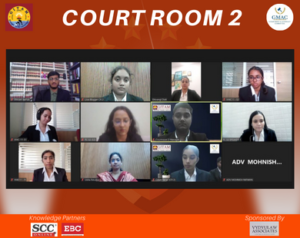
3:35 PM: In Court Room 1, VMC 12 mentioned that the Digital Data Privacy Act requires companies dealing with such issues to issue notices. They also completed their rebuttals.
3:40 PM: In Court Room 1, the judges praised the organizing committee and concluded the session.
3:42 PM: In Court Room 2, Speaker 2 of VMC 11, discussed the need for guidelines for data protection and suggested that the government should establish strict regulations for the protection of AI (Artificial Intelligence). When questioned by the judge about privacy violations, Speaker 2 responded that merely storing data itself could be considered a violation of privacy. They also mentioned that if there is a data leak, the company may not be held liable due to disclaimers.
3:45 PM: In Court Room 2, Speaker 2 of VMC 11, presented their prayer. The judge then asked about the writ of quo warranto, seeking clarification on the basis for invoking it as a counter.
3:48 PM: In Court Room 2, the judge inquired whether they could grant leave to add a prayer for a declaration suit under Section 34 of the Specific Relief Act 1963 to compensate for the loss incurred by their client.
3:50 PM: In Court Room 2, the rebuttals have commenced with VMC 32 raising concerns about the misinterpretation of parties.
3:52 PM: In Court Room 2, VMC 11 has begun with their rebuttals.
3:57 PM: In Court Room 2, speaker 2 of VMC 11 is discussing the cause title, and date, and requesting additions to the dismissal of the suit in their rebuttals.
4:00 PM: In Court Room 2, VMC 11 has completed their rebuttals and has ended the session.
With this, the Semi-Finals have concluded…
With DAY 3 behind us, we’re eager to dive into DAY 4!
DAY 4
08th October 2023
FINALS!!!
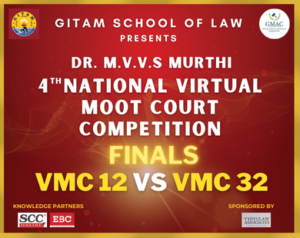
With great anticipation, we begin the last day of our event, excited to witness the captivating final rounds and the celebratory valedictory session graced by our esteemed dignitaries.
Following an intense Semi-final session, here are the teams advancing to the finals:
TEAMS
VMC 12 vs VMC 32
2:06 PM: The court manager initiated the proceedings by announcing the rules and clarifying the schedule and teams.
2:08 PM: The respondent VMC 32, raised objections regarding the petitioner’s memorial.
2:10 PM: VMC 12 (Petitioner) initiated their arguments by clarifying the party they represent and presenting the relevant facts of the case.
2:12 PM: In their first argument, VMC 12 asserted that they are protected under the category of literary works.
2:15 PM: Speaker 1 of VMC 12, moved on to the topic of audio tapping, copyright protection, and infringement, along with relevant provisions.
2:18 PM: Speaker 1 of VMC 12, mentioned Section 52 of the Copyrights Act 1957 and faced a question from the judge regarding the relief they seek.
2:20 PM: The judge directed questions to VMC 12, inquiring about the amendments related to copyright law and seeking clarification on which elements can be copied and which must remain protected.
2:22 PM: Speaker 1 of VMC 12, justified their argument by explaining the rationale behind creating modified copyright and elaborating on the underlying intentions that led to their stance.
2:25 PM: Speaker 1 of Vmc 12, listed some of the prohibited activities that had been violated, highlighting instances of breach.
2:30 PM: Speaker 1 of VMC12, presented justifications related to the facts when prompted by the judge, stating a more detailed explanation for their arguments.
2:32 PM: Speaker 2 of VMC 12, made two key points: (i) The Grant of patent is valid; (ii) They emphasized that this is a clear case of infringement.
2:35 PM: Speaker 2 of VMC 12 provided an explanation of how the breach of privacy can be justified. They delved into the concept of private data, particularly in relation to the audio recording feature of technology. They argued that obtaining this feature does not constitute a breach of data privacy without proper consent.
2:37 PM: Speaker 2 of VMC 12, further discussed the legal aspects, referring to the Data Protection Bill 2023 and the Information Technology Act 2000. They also cited a relevant case law to support their argument that the specific technology in question does not fall under the ambit of infringement of privacy.
2:38 PM: Speaker 2 of VMC 12, outlined the criteria for obtaining a patent and clarified that their case does not infringe on the grounds of public policy, supporting their argument regarding patent validity.
2:40 PM: Speaker 2 of VMC 12, referred to Section 48 of the Patents Act 1970 and cited a relevant case law to emphasize that third parties are barred from using the patented technology. They further argued that under Section 48, the creation of a modified version of the software constitutes a gross infringement.
2:43 PM: Speaker 2 of VMC 12 discussed the concept of prior art, the improvements made to the technology in question, and its distinctive features.
2:45 PM: The judge posed a question regarding the statement of issues as presented in VMC12’s memorial, seeking clarification, and additional information on that aspect.
2:50 PM: In response to the judge’s question about how they can claim infringement when the opposing party created another software, Speaker 2 of VMC 12 explained that their software had been modified and was not freely available. They further asserted that the opposing party had hacked into their modified software and made it public, emphasizing that the functionality of the software remained the same, with identical source code.
2:53 PM: Speaker 2 of VMC 12 concluded their argument by requesting an injunction order against the defendant and asserting that the writ was not maintainable in this case.
2:55 PM: Speaker 1 of VMC 32, representing the respondent, started her arguments by providing a concise overview of the relevant facts in the case.
2:56 PM: Speaker 1 of VMC 32 began her arguments by outlining the key issues:
(i) Issue 1: Whether the writ of quo warranto is maintainable.
(ii) Issue 2: Whether the patent is subject to revocation.
(iii) Issue 3: Whether there is an infringement of copyright.
(iv) Issue 4: Whether the suit against Henry is maintainable.
2:58 PM: Speaker 1 of VMC 32, provided clarifications from the facts regarding the identity of the petitioner and respondent in the case. They also referred to the legal precedent of Maruti Suzuki vs. Delhi Authority to support their argument and clarify relevant points in the case.
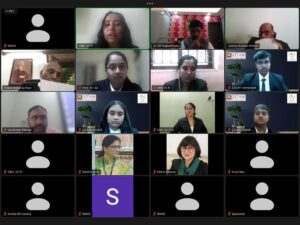
3:00 PM: Speaker 1 of VMC 32, Referred to the precedent Mahadevan vs Bala sundaran.
3:05 PM: Speaker 1 of VMC 32 explained how they can invoke the High Court with a writ of quo warranto, likely citing relevant legal provisions or precedents to support their argument.
3:10 PM: Speaker 1 of VMC 32 cited the case of Rajgopal vs. State of Tamil Nadu as a reference, likely to bolster their argument and provide a legal precedent relevant to the case.
3:15 PM: Speaker 1 of VMC 32, stated about the right to privacy, likely in connection with the Puttaswamy judgment, and asserted that a modified version of a refrigerator should not be considered as an invention. This argument appears to be part of their defense against patent claims.
3:20 PM: Speaker 1 of VMC 32, refers to Section 64 of the Patent Act 1970 and a legal precedent: Mitesh Agarwal vs Assistant Commissioner.
3:25 PM: Speaker 2 of VMC 32 talks about the recognition of Piracy under the Indian judiciary
Referring to a case law: Govind vs state of Madya Pradesh.
3:30 PM: Speaker 2 of VMC 32, talks about the concept of the Role of open-source software and innovation, & reverse engineering.
3:33 PM: Speaker 2 of VMC 32, refers to a 2015 case to understand the scope of fair use under the Copyright Act 1957.
3:38 PM: Speaker 2 of VMC 32, mentioned the concept of a general licensing scheme and argued that Henry’s modification does not constitute infringement. They emphasized that the petitioner must first establish the validity of their patent before claiming infringement.
3:40 PM: Speaker 2 of VMC 32, also referred to the case of “Roche vs. Cipla,” where the Mumbai High Court stated a similar position, likely to support their argument.
3:43 PM: Speaker 2 of VMC 32 concludes her arguments with prayer.
3:45 PM: Speaker 1 of VMC 12 starts her rebuttals.
3:47 PM: Speaker 1 of VMC 12, addressed the contentions put forward by the respondents regarding the counter software.
3:50 PM: Speaker 2 of VMC 32, started their rebuttals.
3:55 PM: Speaker 2 of VMC 32, addressed the first contention regarding public morality, emphasizing that the storage of audio recordings not only violated the petitioner’s rights but also the broader public’s rights. They also discussed the issue of consent and whether it had been obtained for the usage of the software.
4:00 PM: Speaker 2 of VMC 32 highlighted the confusion between the writ of mandamus and quo warranto, likely based on the arguments and submissions made during the proceedings.
4:05 PM: During the proceedings, the judge posed a question to Speaker 2 of VMC 32, referring to the Data Protection Bill 2023.
4:10 PM: After an engrossing round of rebuttals, the proceedings in the Courtroom have come to an end….
The Final Round has now come to an end and we eagerly await the result!
Valedictory Ceremony
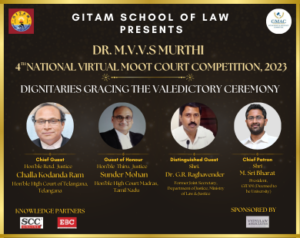
4:40 PM: The Ceremony Began with Prof. Dr. Anita Rao ma’am addressing the gathering followed by Asst. Prof. Ms. Rhea Hundal welcomed the honorable guests and dignitaries.
4:42 PM: Rhea Ma’am addressed the forum and gracefully passed over to Mr. Abhay Nadan student coordinator, a fourth-year student.
4:45 PM: Furthermore, Mr Abhay Nandan student coordinator shared the achievements and qualifications of the honorable Judge G.R. Raghavendra with the audience.
4:47 PM: Honorable Judge G.R. Raghavendra began his speech to the gathered audience.
4:55 PM: The student coordinator addressed the achievements of the Honorable Retd. Justice Challa Kodanda Ram.
5:05 PM: Honorable Retd. Justice Challa Kodanda Ram shared insights into his previous experiences in moot competitions and his area of expertise in advocacy.
5:10 PM: Distinguished Guest Mr. Raghavendra expressed his admiration for the participants’ dedicated research efforts and acknowledged the challenges they faced during the moot competition.
5:15 PM: Prof. Dr. Anita Rao ma’am addressed and thanked the judges and congratulated all the participants, the committee members, faculty advisors, and all the knowledge partners. She then proceeded to announce the results of the Dr M. V. V. S. Murthi 4th National Virtual Moot Court Competition.
The most awaited results are out!!!
Best Researcher – Anukriti Singh (VMC24 – O.P. Jindal Global University)
Best Speaker – Adhiti Sharma (VMC12 – Christ (Deemed to be) University)
Best Memorial – VMC32, Vivekananda School of Law and Legal Studies
Runner up – VMC32, Vivekananda School of Law and Legal Studies
Winner – VMC12, Christ (Deemed to be) University
5:28 PM: Moot Court Convener and Asst. Prof. Mr. Vardhman S Panwar stated the inspiration behind the Moot Court Proposition which was related to patent and copyright and how individuals are given a chance to protect their IP. He extended his vote of thanks to the honorable Judges, participants, and teaching and non-teaching staff. He also congratulated the winners and runner-ups of the competition.







